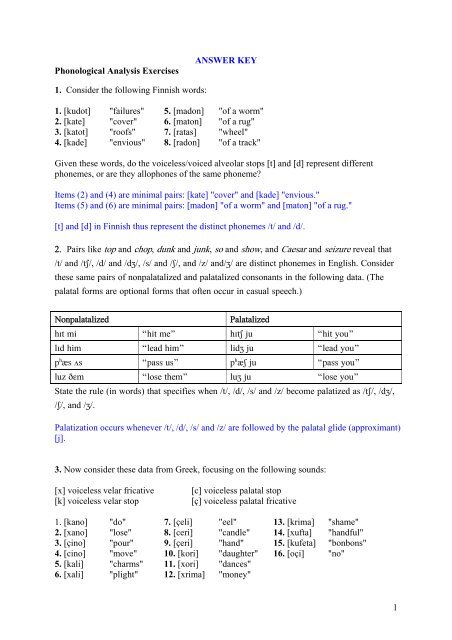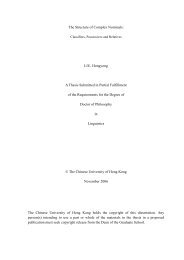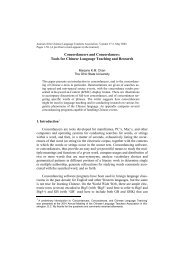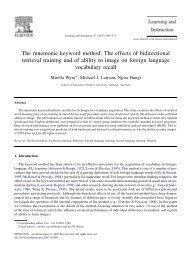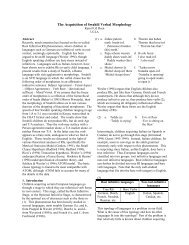ANSWER KEY Phonological Analysis Exercises 1. Consider the ...
ANSWER KEY Phonological Analysis Exercises 1. Consider the ...
ANSWER KEY Phonological Analysis Exercises 1. Consider the ...
You also want an ePaper? Increase the reach of your titles
YUMPU automatically turns print PDFs into web optimized ePapers that Google loves.
<strong>Phonological</strong> <strong>Analysis</strong> <strong>Exercises</strong><br />
<strong>ANSWER</strong> <strong>KEY</strong><br />
<strong>1.</strong> <strong>Consider</strong> <strong>the</strong> following Finnish words:<br />
<strong>1.</strong> [kudot] "failures" 5. [madon] "of a worm"<br />
2. [kate] "cover" 6. [maton] "of a rug"<br />
3. [katot] "roofs" 7. [ratas] "wheel"<br />
4. [kade] "envious" 8. [radon] "of a track"<br />
Given <strong>the</strong>se words, do <strong>the</strong> voiceless/voiced alveolar stops [t] and [d] represent different<br />
phonemes, or are <strong>the</strong>y allophones of <strong>the</strong> same phoneme?<br />
Items (2) and (4) are minimal pairs: [kate] "cover" and [kade] "envious."<br />
Items (5) and (6) are minimal pairs: [madon] "of a worm" and [maton] "of a rug."<br />
[t] and [d] in Finnish thus represent <strong>the</strong> distinct phonemes /t/ and /d/.<br />
2. Pairs like top and chop, dunk and junk, so and show, and Caesar and seizure reveal that<br />
/t/ and /tʃ/, /d/ and /dʒ/, /s/ and /ʃ/, and /z/ and/ʒ/ are distinct phonemes in English. <strong>Consider</strong><br />
<strong>the</strong>se same pairs of nonpalatalized and palatalized consonants in <strong>the</strong> following data. (The<br />
palatal forms are optional forms that often occur in casual speech.)<br />
Nonpalatalized<br />
Palatalized<br />
hɪt mi “hit me” hɪtʃ ju “hit you”<br />
lɪd him “lead him” lidʒ ju “lead you”<br />
p h æs ʌs “pass us” p h æʃ ju “pass you”<br />
luz ðɛm “lose <strong>the</strong>m” luʒ ju “lose you”<br />
State <strong>the</strong> rule (in words) that specifies when /t/, /d/, /s/ and /z/ become palatized as /tʃ/, /dʒ/,<br />
/ʃ/, and /ʒ/.<br />
Palatization occurs whenever /t/, /d/, /s/ and /z/ are followed by <strong>the</strong> palatal glide (approximant)<br />
[j].<br />
3. Now consider <strong>the</strong>se data from Greek, focusing on <strong>the</strong> following sounds:<br />
[x] voiceless velar fricative<br />
[k] voiceless velar stop<br />
[c] voiceless palatal stop<br />
[ç] voiceless palatal fricative<br />
<strong>1.</strong> [kano] "do" 7. [çeli] "eel" 13. [krima] "shame"<br />
2. [xano] "lose" 8. [ceri] "candle" 14. [xufta] "handful"<br />
3. [çino] "pour" 9. [çeri] "hand" 15. [kufeta] "bonbons"<br />
4. [cino] "move" 10. [kori] "daughter" 16. [oçi] "no"<br />
5. [kali] "charms" 1<strong>1.</strong> [xori] "dances"<br />
6. [xali] "plight" 12. [xrima] "money"<br />
1
To determine <strong>the</strong> status of [x], [k], [c], and [ç], you should answer <strong>the</strong> following questions.<br />
a. Are <strong>the</strong>re are any minimal pairs in which <strong>the</strong>se sounds contrast?<br />
b. Are any noncontrastive sounds in complementary distribution?<br />
c. If noncontrasting phones are found, what are <strong>the</strong> phonemes and <strong>the</strong>ir allophones?<br />
d. What are <strong>the</strong> phonological rules by which <strong>the</strong> allophones can be derived?<br />
a. By analyzing <strong>the</strong> data, we find that [k] and [x] contrast in a number of minimal pairs, for<br />
example, in [kano] and [xano]. [k] and [x] are <strong>the</strong>refore distinctive. [c] and [ç] also contrast in<br />
[çino] and [cino] and are <strong>the</strong>refore distinctive. But what about <strong>the</strong> velar fricative [x] and <strong>the</strong><br />
palatal fricative [ç]? And <strong>the</strong> velar stop [k] and <strong>the</strong> palatal stop [c]? We can find no minimal<br />
pairs that would conclusively show that <strong>the</strong>se represent separate phonemes.<br />
b. We now proceed to answer <strong>the</strong> second question: Are <strong>the</strong>se noncontrasting phones, namely<br />
[x]/[ç] and [k]/[c], in complementary distribution? One way to see if sounds are in<br />
complementary distribution is to list each phone with <strong>the</strong> environment in which it is found, as<br />
follows:<br />
Phone<br />
[k]<br />
[x]<br />
[c]<br />
[ç]<br />
Environment<br />
before [a], [o], [u], [r]<br />
before [a], [o], [u], [r]<br />
before [i], [e]<br />
before [i], [e]<br />
We see that [k] and [x] are not in complementary distribution; <strong>the</strong>y both occur before back<br />
vowels. Nor are [c] and [ç] in complementary distribution. They both occur before front<br />
vowels. But <strong>the</strong> stops [k] and [c] are in complementary distribution; [k] occurs before back<br />
vowels and [r], and never occurs before front vowels. Similarly, [c] occurs only before front<br />
vowels and never before back vowels or [r]. Finally, [x] and [ç] are in complementary<br />
distribution for <strong>the</strong> same reason. We <strong>the</strong>refore conclude that [k] and [c] are allophones of one<br />
phoneme, and <strong>the</strong> fricatives [x] and [ç] are also allophones of one phoneme. The pairs of<br />
allophones also fulfill <strong>the</strong> criterion of phonetic similarity.<br />
c. Which of <strong>the</strong> phone pairs are more basic, and hence <strong>the</strong> ones whose features would define<br />
<strong>the</strong> phoneme? When two allophones can be derived from one phoneme, one selects as <strong>the</strong><br />
underlying segment <strong>the</strong> allophone that makes <strong>the</strong> rules and <strong>the</strong> phonemic feature matrix as<br />
simple as possible, as we illustrated with <strong>the</strong> English unaspirated and aspirated voiceless<br />
stops. In <strong>the</strong> case of <strong>the</strong> velar and palatal stops and fricatives in Greek, <strong>the</strong> rules appear to be<br />
equally simple. However, in addition to <strong>the</strong> simplicity criterion, we wish to state rules that<br />
have natural phonetic explanations. Often <strong>the</strong>se turn out to be <strong>the</strong> simplest solution. In many<br />
languages, velar sounds become palatal before front vowels. This is an assimilation rule;<br />
palatal sounds are produced toward <strong>the</strong> front of <strong>the</strong> mouth, as are front vowels. Thus we<br />
select /k/ as a phoneme with <strong>the</strong> allophones [k] and [c], and /x/<br />
as a phoneme with <strong>the</strong> allophones [x] and [ç]<br />
d. We can now state <strong>the</strong> rule by which <strong>the</strong> palatals can be derived from <strong>the</strong> velars.<br />
Palatalize velar consonants before front vowels.<br />
Using feature notation we can state <strong>the</strong> rule as:<br />
[+velar] ---> [+palatal] /__ [-back]<br />
Students may only know this way of writing <strong>the</strong> rule:<br />
2
[velar consonant] ---> [palatal consonant] /__ [Front vowel]<br />
Because only consonants are marked for <strong>the</strong> feature [velar], and only vowels for <strong>the</strong> feature<br />
[back], it is not necessary to include <strong>the</strong> features [consonantal] or [syllabic] in <strong>the</strong> rule. We<br />
also do not need to include any o<strong>the</strong>r features that are redundant in defining <strong>the</strong> segments to<br />
which <strong>the</strong> rule applies or <strong>the</strong> environment in which <strong>the</strong> rule applies. Thus [+palatal] in <strong>the</strong><br />
change part of <strong>the</strong> rule is sufficient, and <strong>the</strong> feature [- back] also suffices to specify <strong>the</strong> front<br />
vowels. The simplicity criterion constrains us to state <strong>the</strong> rule as simply as we can.<br />
3


